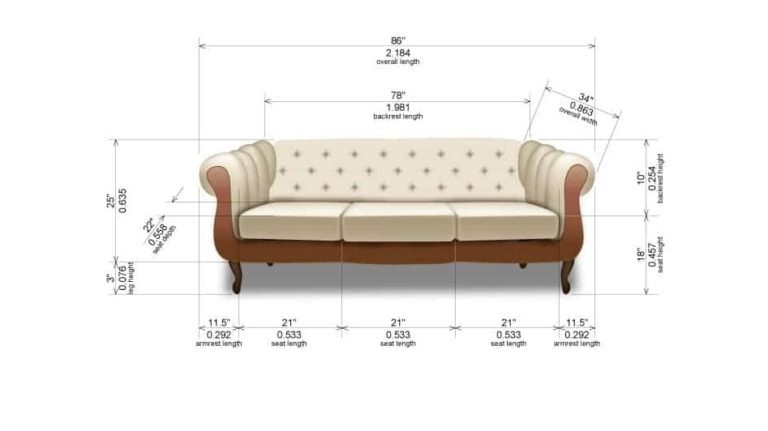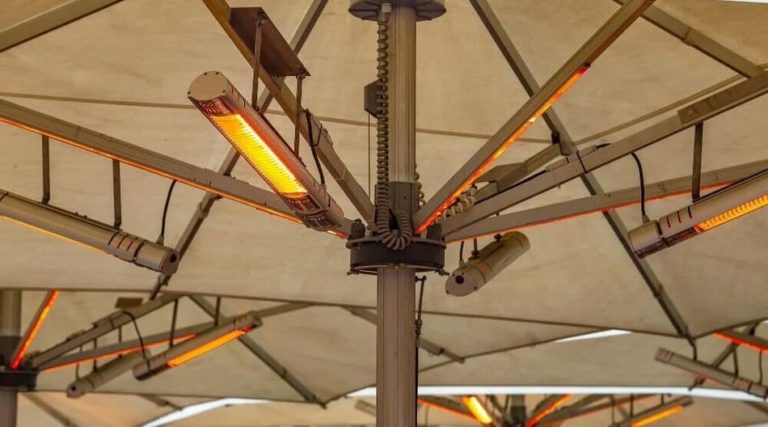6 Types Of Space Heaters (Pros and Cons)
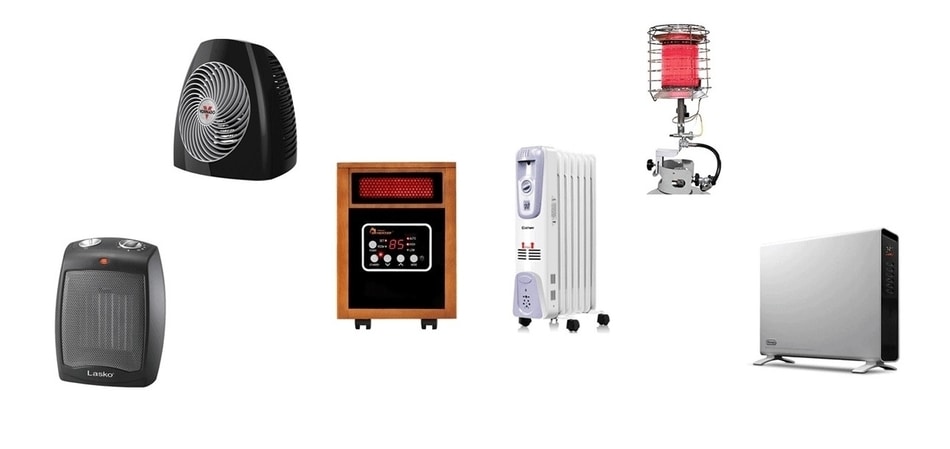
If you are considering buying some space heaters for your home, you’re at the right place. During cold winters it is good to have some space heaters in your home to keep you warm. But which model to buy? What do you need to pay attention to when buying? In this article, we’ll explain in detail all the important parts and what you need to know about space heaters. So let’s go!
Table of Contents
What Are Space Heaters?
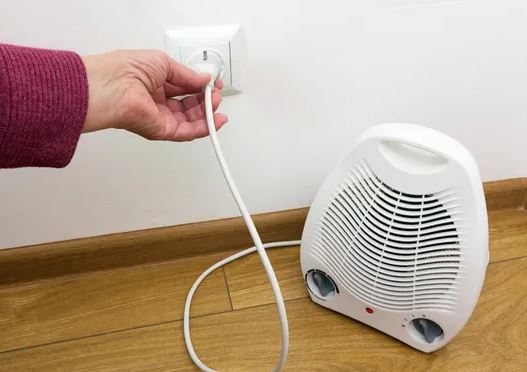
A space heater is a device used to heat a small, medium, or large-sized room. They usually come in small sizes and can be transposed easily and used anywhere. They are otherwise a very good heating source because they use very little energy to heat a room and thus do not affect your energy bill much. Many households use them today, and they can be found in almost all electronic equipment stores.
For those who own a baseboard heater, this article may be handy; How to Calculate Total Wattage of Baseboard Heaters.
Different Types Of Portable Heaters
Portable heaters can be classified into three groups based on how they produce heat: radiant heaters, convection heaters, and a combination of those two types. The main difference is in how they produce heat. Let’s take a close look and see how each of them operates.
1. Radiant Heaters
Radiant heaters use infrared rays to warm up people or other objects in the room. They are best suited for spot heating of parts of a room that are placed in front of them. They don’t produce any sound, and they are highly energy-efficient. They can easily heat a space of 1,000 square feet compared to the convection heater that can heat around 400 square feet.
Unfortunately, they do have some drawbacks. While using radiant heaters, you need to be very careful about positioning them. They can’t easily trigger a fire. Also, they are inappropriate for bedrooms because of the orange light it emits.
2. Convection Heaters
Convection heaters are best suited for heating large spaces and rooms. They are very easily maintained and don’t need any cleaning. They use oil and produce heat from an external surface area. Convection heaters are designed in a way to heat the room’s air and not the people.
Most of them have a fan that distributes hot air throughout the room for improved air circulation. I think you all now have a pretty clear idea of why they are called ‘fan’ heaters. When you need to heat a room swiftly and quietly, convection heaters are the way to go. However, they are not the best choice if you have children or pets in the room.
3. Combination Heaters
These heaters are ideal to be used in any room and provide the simplest convection and radiant heating. Also, combination heaters come with a fan that distributes heat, and they are not so efficient as other models of heaters.
6 Different Types Of Space Heaters
Based on the portable heaters that we mentioned above, space heaters are further classified into these six types:
1. Infrared Space Heater
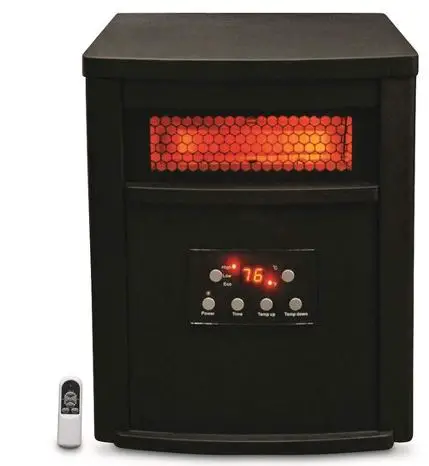
Infrared space heaters are using electricity to heat the room. These heaters use electromagnetic waves to heat the objects and people in the room and they are ideal for warming up large spaces. As electromagnetic waves heat the space these heaters do not require a fan. However, some with fans can help speed up the whole process. Here are some of the pros and cons of infrared space heaters.
Pros
- Some models come with wheels or a handle and they are easily portable.
- You can switch them off and still feel the heat.
- They are perfect for heating large spaces.
- Some of them will easily fit with furniture because of their wooden designs.
- You can put it anywhere because the objects just consume heat and don’t block it.
- Some units even have a thermostat.
- Resembles real fireplaces.
Cons
- More expensive than ceramic and fan heaters.
- Heat is dispersed in all directions.
- Heavy.
- These heaters require physical objects to absorb heat.
2. Fan Space Heaters
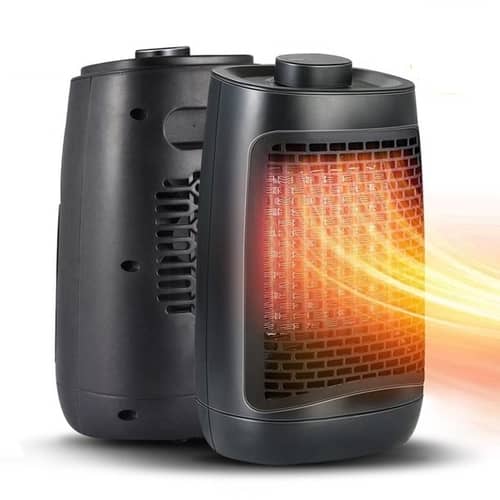
Fan space heaters are using heated metal coils to transfer the heat into the air. To push heat into the room, they have fans that are blowing all over the metallic coil. Here are the pros and cons of fan space heaters.
Pros
- Heating that is cool to the touch.
- Cheap heating.
- Produces instantaneous, oscillating heat.
- The majority of thermostats contain a turn-dial to select a specific level of heat.
- Ideal for apartment that need to heat bathrooms.
Cons
- Not suitable for heating much larger areas.
- When the power is turned off, the heat transmission stops.
- Constantly runs and uses electricity to generate heat.
- Heat transfer can be blocked by physical objects.
3. Ceramic Space Heaters
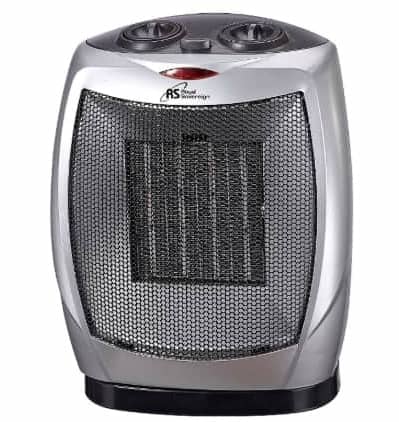
Ceramic space heaters use electricity to operate. They got their name from the ceramic plates that are installed on the metal coils. The working principle on how they operate is when the electricity passes through the coil; it heats up. As the plates absorb electrical heat, they release the heat into space.
There are two types of ceramic space heaters; those with and without a fan. Heaters with fans are called ceramic convection heaters. They blow air over the ceramic heating plates to quickly distribute the air in the room. The radiant models use electricity to heat a ceramic plate, which radiates heat throughout the room. The heating process takes longer due to the lack of a fan.
Pros
- They are compact and portable.
- Extremely efficient.
- They provide instant heat.
- They are safe even for children or pets.
- Because the ceramic plates take time to cool down, heat radiates evenly after shutting off.
Cons
- Noisy.
- The majority of them are continually running and using power to generate heat.
- Insufficient for heating larger areas.
- Heaters that do not have fans take a long time to heat a room.
- Physical objects can easily block the heat transfer.
4. Propane Space Heaters
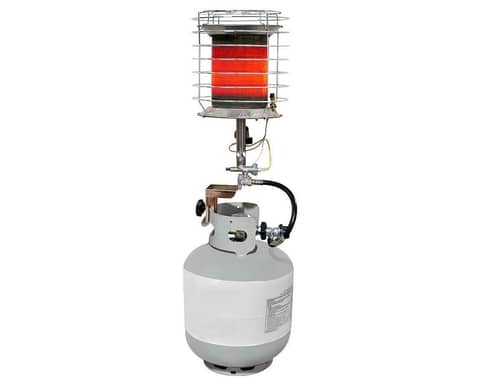
Propane space heaters use liquid propane (LP) to operate. They are the best solution if you like portable space heaters that don’t require power cords. They can heat your home by emitting electromagnetic waves into the air, and they can serve you when there is no electricity in your house. They produce the most intense heat by liquid propane and are 20% cheaper to run than heaters using electricity.
Keep in mind that the oxygen level can be reduced, and toxic gases could be released in the room when they run. You have a second variant of propane heaters which are vented for indoor usage. You can even get yourself a model with a fan to quickly bring the heat.
Pros
- Produces the fiercest heat.
- Operation and purchase cost are low.
- Does not require electricity to operate so it is ideal for outdoor heating.
- It’s is portable so power cords aren’t an issue.
Cons
- Some models are not safe for indoor use.
- Some types produce carbon dioxide.
- Fuel must be ready at all times.
- Due to the burning fuel, it poses a fire and explosion risk.
5. Oil-Filled Space Heaters
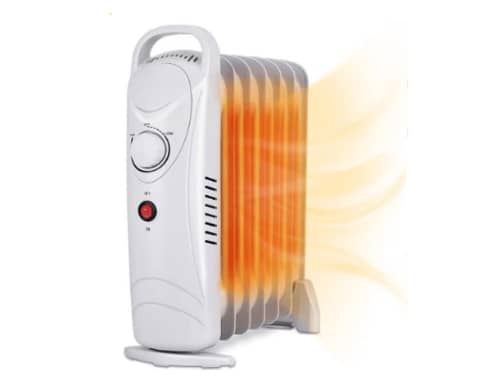
Oil-filled space heaters operate by using electricity; they are portable and come with a diathermic coil. When the oil inside the heater is heated, it circulates through its columns, and that way, it releases hot air. They are also known as radiator heaters because they are very similar to old radiators. These models don’t come with fans because fans are not suitable for distributing heat that is produced by the oil. Here are their pros and cons:
Pros
- Perfect for large spaces.
- Some models even have a thermostat.
- You can switch it off and it will still emit the heat – energy saver.
Cons
- It is one of the heavier heaters (16-20 Ibs).
- You can’t control the speed of heat.
- Don’t have good fluctuation of heat.
- Not suitable for families with children and pets because surface gets hot.
6. Panel Space Heaters
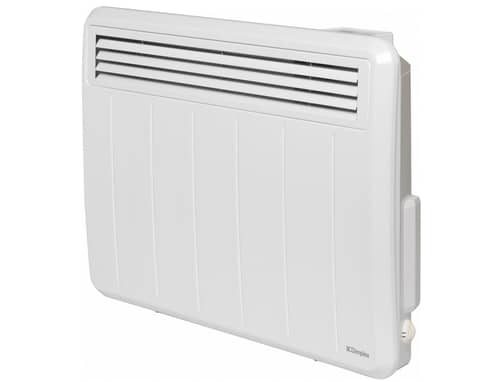
Panel space heaters are relatively new in this world of heaters but they are gaining big popularity. Panel space heaters are easily transportable and can be placed anywhere, even on the wall. You may be thinking, there are also other heaters that can be put on the wall? Yes, there is, but they are not beneficial to allergy suffers.
Panel space heaters produce up to 80% convection heat. Keep in mind that they can’t heat the room, but they can get rid of the cold in a room. It’s because they use the room’s airflow to circulate the heat. With them, there is no recirculation of dust through the room.
Pros
- Perfect for allergy sufferers.
- They have stylish look.
- Simple usage – just plug it in.
- Easily installation to the wall.
- It is safe to use with youngsters.
Cons
- There are very few controls.
- If you put it on the wall you won’t be able to move it around.
- It produces less heat than other space heaters and can merely remove the chill in a room.
Comparisons Of Popular Types Of Space Heaters
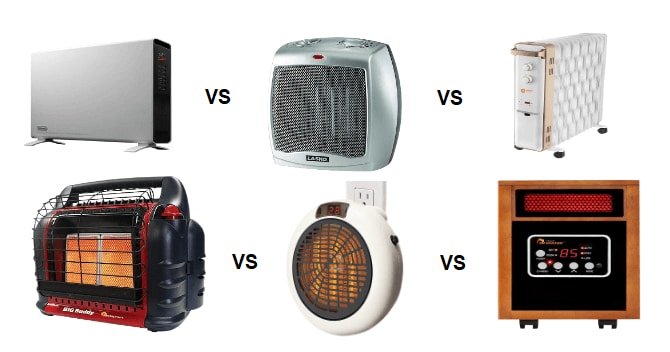
To help you in making your decision on which type of space heater to choose, below are some simple comparisons between the most common space heaters.
1. Ceramic Heater vs. Fan Heater
Both of these types produce a lot of noise. Also, ceramic heaters and fan heaters are using fans to operate.
Ceramic Heaters:
- They’re not designed to heat large areas.
- It instantly heats up tiny areas.
- They are very efficient but also noisy.
- Pet and children friendly.
- They retain heat and release out more heat into the air.
Fan Heaters:
- Inexpensive and easily transportable.
- They produce instant heat.
2. Ceramic Heater vs. Oil-Filled Heater
Oil Heaters:
- Takes a long time to heat up.
- They are silent.
- They are large and heavy.
- Perfect for heating large spaces.
- It is not recommended for households with small children.
- Too much time required for cooling down.
Ceramic Heaters:
- Pet and children friendly.
- Cools down quickly.
- Smaller and easier to transport.
- Noisy.
- Heats up quickly and may be used for spot heating.
3. Fan Heaters vs. Infrared Heaters
For those who want to provide instant heat and need to lower humidity and oxygen levels in the room, these types are for you. Not forget to mention both are cost-effective.
Infrared Heaters:
- Use only 400 – 800 watts of energy.
- Not recommended for children and pets.
- Perfect for smaller rooms.
Fan Heaters:
- Use plenty of energy (approximately 2000 watts of energy).
- Cheap and easy to move.
- Perfect for large areas.
4. Infrared Heaters vs. Oil-Filled Heaters
Both of these models are energy efficient and they don’t produce much noise during operation. Here are some of their benefits.
Infrared Heaters:
- Not really efficient in heating big spaces.
- Not recommended for families with pets and kids.
Oil-Filled Heaters:
- Not recommended for families with pets and children.
- Ideal for heating large spaces.
- Not really effective in releasing instant heat.
- Costly.
5. Fan Heaters vs. Oil-Filled Heaters
Both of these models are great choices for heating large rooms:
Oil-Filled Room Heaters:
- They require around 30 min to heat up and reach desired temeprature.
- They are heavy and hard to transport.
- Saves energy because the heater stays hot for hours after it is turned off.
- Unsuccessful in lowering humidity levels.
- Not burning oxygen.
- Noisy.
Fan Heaters:
- They are friendly for pets and children.
- Heats up quickly.
- Noisy.
- Use more energy power, it might have high impact on your energy bill.
- Rapidly loses heat and must be kept on high power to maintain room temperature.
Types Of Space Heaters For Rooms
1. Infrared Portable Heaters Are Ideal For Heating:
- Offices, living rooms, and small rooms.
2. Fan Heaters Are Ideal For Heating:
- Basements with good insulation.
- A room for children.
- An entire bedroom or living room.
- Small offices and utility rooms.
3. Propane Heaters Are Ideal For Heating:
- During blackouts.
- Open air spaces like studio, workshops, or external garages.
4. Oil-Filled Heaters Are Ideal For Heating:
- Large rooms and areas.
- Bedrooms.
- Low insulated basements.
5. Panel Space Heaters Are Ideal For:
- Offices, bedrooms, bathrooms, and small rooms.
Related article: Basics About Water Heaters: Types, Parts & How They Work.
FAQ: People Also Ask
Which Type Of Heater Is The Best?
Although it all depends on the purpose, convection oil-filled heaters are used to heat large areas, but ceramic heaters are mostly used and are very popular.
Which Heaters Are Safe To Leave On Overnight?
The heaters that are safe to leave during the night are infrared, oil heaters, and ceramic ones. However, it is not recommended to have electric and vented propane heaters before sleeping.
Which Type Of Heater Is The Cheapest To Run?
Propane space heaters are around 20% cheaper to run than space heaters that use electricity. However, not all models are suitable for indoor use. On the other hand, electric heaters are 100% efficient because they are not wasting heat.
Final Thoughts
We were able to see all six types of space heaters that are available in the market. Each of them has its advantages and disadvantages. When choosing a space heater, you need to consider what you will use it for in order to choose the best model to use. I hope this article helped you, so if you have any questions feel free to contact us.


